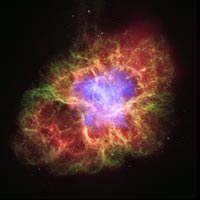Welcome to the Carnival of space week 23. We have two articles inspired by the 50th anniversary of Sputnick, then we have a mixed bag of articles on raising pigs on Mars, habitable planets, another look at the Apollo program, Nasa colorizing of space photos, the Carancas meteorite, Type 1a Supernovae, my own submission on hypersonic aircraft status, our wonderful planet Earth and there is a formula for the universe.
Sputnick
Cumbrian Sky talks about Space Age: RIP
As the 50th anniversary of the launch of Sputnik 1 approaches, amateur astronomer and spaceflight enthusiast Stuart Atkinson has mixed feelings about what has – and hasn’t – happened in the last 50 years, and wonders if it’s time to declare the “Space Age” dead…
Astroprof’s Page discusses 50 Years Ago
This post is about the 50th anniversary of the launch of Sputnik-1. I also include a link for a wav of the Sputnik beeping.
UPDATE: Missed article=================
Astroblog also talks about the 50th Anniversary of Sputnik Launch
============================
Colony Worlds talks about
Raising Pigs On Mars
The first explorers upon Mars will probably rely on supplies previously shipped to the red planet in order to survive upon this harsh world. But in order to settle on this crimson globe, future Martians will need to import fruits, vegetables, grain, trees and pigs–yes pigs.
Centauri Dreams talks about “Habitable Planets: A Splendid Isolation”
The story discusses recent work on planet formation and suggests habitable terrestrial worlds may form around stars that have had few or no interactions with other stars in their past. It’s something of a brake on the idea that Earth-like planets are forming in binary systems, but it also contradicts recent research that they could indeed form there. Controversy should follow.
Music of the Spheres talks about Moonshadow Men
FlyingSinger has been busy with travel but did take time to see a wonderful new documentary about the Apollo program, “In the Shadow of the Moon.” Produced by Ron Howard and in limited theatrical release, the story is told through recent interviews with ten of the astronauts who journeyed to the Moon from 1968 to 1972. Inspiring stuff!

Universe Today talks about
True or False (Color): The Art of Extraterrestrial Photography
If you could see the surface of Mars, or a spectacular nebula with your own eyes, would it look the same as the beautiful images from Hubble, or the Mars rovers? Sometimes yes, mostly no. Universe Today has this
article about the techniques astronomers use to coax the best images out of their data.
Spacefiles talks about the Carancas meteorite, Peru What have we learned of the meteorite that fell in Peru on Sept 15, 2007 ?

At Star Stryder talks about
Type 1a Supernovae: A Non-Standard Candle
Astronomers have been working hard to document the universe’s rate of expansion as a function of time. To do this, we have to know how much light SN give off, and new research is indicating that this is going to get tricky as we look farther and farther back toward the beginning of the universe.
My own submission is an update and status of hypersonic aircraft and engine development
Olivier Lussier presents Home Sweet Home: Our Wonderful Earth posted at olussier.com.
A Babe in the Universe talk about a formula for the universe
An episode of STAR TREK hinted that the whole Universe could be expressed in a simple equation. Max Planck created a universal system of units based on c, h and G. Use of Planck’s units leads to an amazingly simple result: “M = R = t”
This expression could tell a lot about the Universe, but may be ahead of its time.

Brian Wang is a Futurist Thought Leader and a popular Science blogger with 1 million readers per month. His blog Nextbigfuture.com is ranked #1 Science News Blog. It covers many disruptive technology and trends including Space, Robotics, Artificial Intelligence, Medicine, Anti-aging Biotechnology, and Nanotechnology.
Known for identifying cutting edge technologies, he is currently a Co-Founder of a startup and fundraiser for high potential early-stage companies. He is the Head of Research for Allocations for deep technology investments and an Angel Investor at Space Angels.
A frequent speaker at corporations, he has been a TEDx speaker, a Singularity University speaker and guest at numerous interviews for radio and podcasts. He is open to public speaking and advising engagements.


Comments are closed.